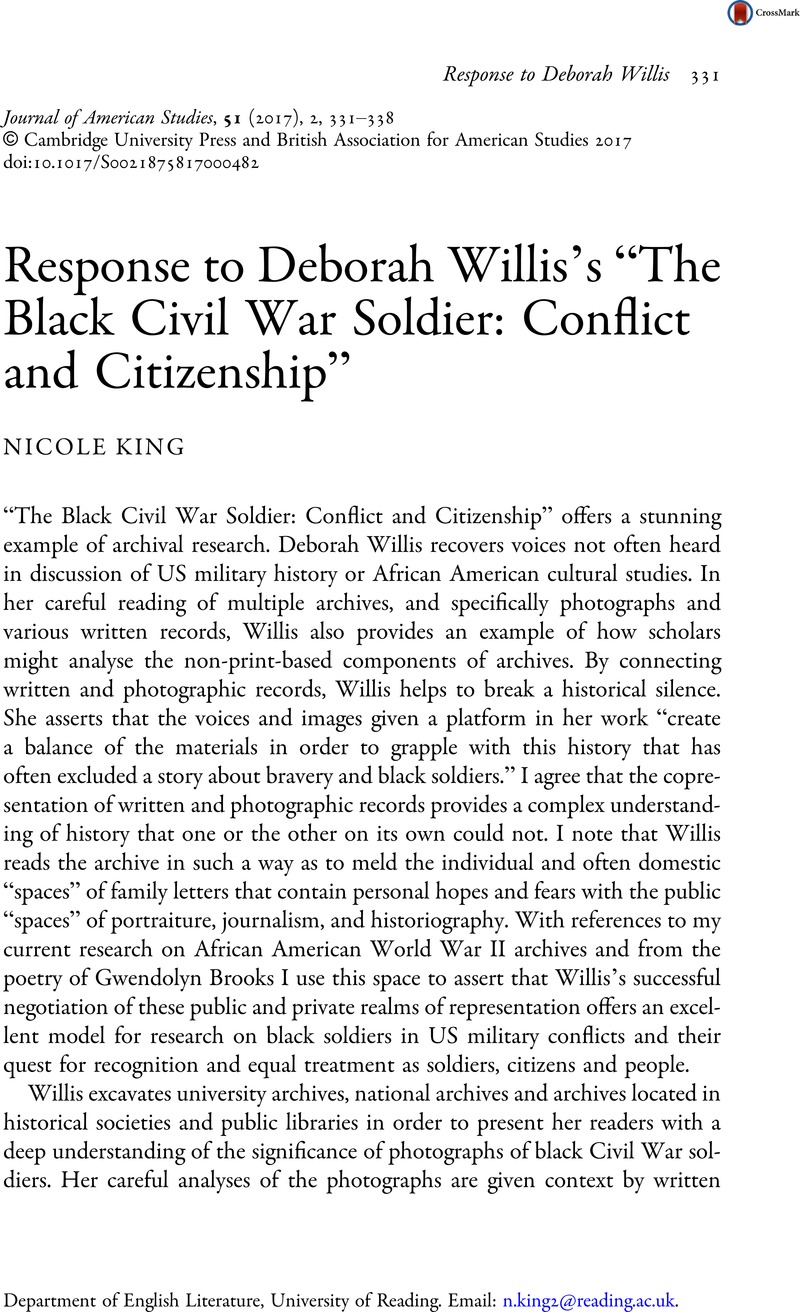No CrossRef data available.
Article contents
Response to Deborah Willis's “The Black Civil War Soldier: Conflict and Citizenship”
Published online by Cambridge University Press: 08 May 2017
Abstract

- Type
- Forum
- Information
- Copyright
- Copyright © Cambridge University Press and British Association for American Studies 2017
References
1 Recent scholarship has delved into other aspects of creative imagining, archives and African American war experiences. See Bernier, Celeste Marie, Characters of Blood: Black Heroism in the Transatlantic Imagination (Charlottesville: University of Virginia Press, 2012)Google Scholar; Bernier, , Suffering and Sunset: World War I in the Art and Life of Horace Pippin (Philadelphia: Temple University Press 2015)Google Scholar; and James, Jennifer C., A Freedom Bought with Blood: African American War Literature from the Civil War to World War II (Chapel Hill: University of North Carolina Press, 2007)Google Scholar. In fiction, Half Blood Blues by Edugyan, Esi (London: Serpent's Tail, 2011)Google Scholar is particularly skilful in its representation of complex racialized experiences of World War II, and, like Moten's, Fred In The Break: The Aesthetics of the Black Radical Tradition (Minneapolis: University of Minnesota Press, 2003)Google Scholar, Half-Blood Blues reminds us of the centrality of improvisation to representations and understandings of black diasporan narratives. Finally, Hans Massaquoi's autobiography Destined to Witness: Growing Up Black in Nazi Germany (New York: HarperCollins, 1999)Google Scholar emphatically disrupts singular notions of Afro-German and black US experiences of World War II.
2 Foucault, Michel, The Archaeology of Knowledge and the Discourse on Language (Abingdon: Routledge Classics, 2002; first published 1969)Google Scholar.
3 See McGuire, Phillip, Taps for a Jim Crow Army: Letters from Black Soldiers in World War II (Santa Barbara and Oxford: ABC-Clio, 1983), 79–80 Google Scholar.
4 James, 19.
5 Ibid.
6 Brooks, Gwendolyn, Selected Poems (New York: Harper and Row, 1963) 22Google Scholar.
7 Brooks, Gwendolyn, Report from Part One (Detroit: Broadside Press, 1972), 156Google Scholar.
8 Brooks, Selected Poems, 24.
9 McGuire, 59, writes, “Although they were assigned to every branch of the services opened to them, the Army confined most of the [black] troops to the Service forces … These assignment practices resulted in blacks being trained almost exclusively for noncombat functions as laborers, stevedores, and servants.”
10 James, 239.
11 The poem's final two lines also invoke Doris “Dorie” Miller, an African American war hero of the Pearl Harbour attack, who did “beat back the storm” of Japanese airstrikes and did “haul” others from harm, and who was particularly brawny, but who died in a later battle nonetheless. In “Negro Hero,” a poem written at the same time that sits, however, outside the “gay chaps at the bar” series, Brooks provides a direct response to the iconography that circulated in 1942 of Miller.
12 Alexander, Elizabeth, “Introduction” in The Essential Gwendolyn Brooks, ed. Alexander, (New York: Library of America, 2005), xviiiGoogle Scholar.
13 Brooks, Report from Part One, 156.
14 Alexander, xviii.


